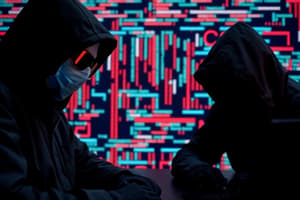Podcast
Questions and Answers
Which type of threat actor primarily engages in activities for financial gain?
Which type of threat actor primarily engages in activities for financial gain?
- Nation-State Actors
- Insider Threats
- Cybercriminals (correct)
- Hacktivists
What is a common motivation for hacktivists in their activities?
What is a common motivation for hacktivists in their activities?
- Financial gain
- Political objectives (correct)
- Thrill-seeking
- Corporate sabotage
Which tactic is NOT associated with the activities of threat actors?
Which tactic is NOT associated with the activities of threat actors?
- Malware
- Data Encryption (correct)
- Phishing
- Social Engineering
What defines an insider threat?
What defines an insider threat?
Which strategy is essential for mitigating the risks posed by threat actors?
Which strategy is essential for mitigating the risks posed by threat actors?
What characteristic is typical of nation-state actors?
What characteristic is typical of nation-state actors?
Which of the following activities is commonly associated with cybercriminals?
Which of the following activities is commonly associated with cybercriminals?
What is the primary motivation of a hacktivist?
What is the primary motivation of a hacktivist?
Which statement about advanced persistent threats (APTs) is correct?
Which statement about advanced persistent threats (APTs) is correct?
What type of threat actor is most likely to work independently to improve security measures?
What type of threat actor is most likely to work independently to improve security measures?
Flashcards are hidden until you start studying
Study Notes
Definition
- Threat actors are individuals or groups who exploit vulnerabilities to conduct malicious activities.
Types of Threat Actors
-
Cybercriminals
- Motivated by financial gain.
- Engage in activities like fraud, identity theft, and ransomware attacks.
-
Hacktivists
- Driven by political or social objectives.
- Use hacking to promote causes or raise awareness.
-
Nation-State Actors
- Operate on behalf of a government.
- Conduct espionage, sabotage, or cyber warfare.
-
Insider Threats
- Individuals within an organization (employees, contractors) who misuse access.
- Can be malicious or unintentional (e.g., negligence).
-
Script Kiddies
- Inexperienced individuals using pre-written scripts or tools.
- Often lack advanced technical skills but can still cause damage.
Motivations
- Financial gain
- Ideological reasons
- Political objectives
- Revenge or thrill-seeking
Tools and Techniques
-
Malware: Software designed to disrupt, damage, or gain unauthorized access to systems.
- Types include viruses, worms, Trojans, and ransomware.
-
Phishing: Deceptive attempts to obtain sensitive information through fraudulent communications.
-
Social Engineering: Manipulating individuals into divulging confidential information.
-
Denial of Service (DoS): Overwhelming a system to make it unavailable to users.
Impact
- Financial losses for organizations.
- Damage to reputation and trust.
- Legal consequences and regulatory fines.
- Compromised data and privacy breaches.
Mitigation Strategies
- Implementing strong cybersecurity measures (firewalls, antivirus).
- Conducting regular security training for employees.
- Maintaining updated software and systems.
- Developing an incident response plan to address breaches swiftly.
- Monitoring networks for unusual activities.
Conclusion
- Understanding threat actors is crucial for developing effective cybersecurity strategies and protecting organizations from potential attacks.
Definition
- Threat actors are entities that exploit vulnerabilities for malicious purposes.
Types of Threat Actors
- Cybercriminals
- Primarily seek financial gain through fraud, identity theft, and ransomware attacks.
- Hacktivists
- Utilize hacking to support political or social causes and raise awareness.
- Nation-State Actors
- Operate under government mandates, engaging in espionage, sabotage, or cyber warfare.
- Insider Threats
- Employees or contractors who misuse their access, either maliciously or through negligence.
- Script Kiddies
- Inexperienced individuals using pre-existing scripts/tools to cause disruption without deep technical knowledge.
Motivations
- Financial rewards
- Ideologies
- Political agendas
- Personal vendettas or excitement
Tools and Techniques
- Malware
- Includes various malicious software types: viruses, worms, Trojans, and ransomware designed to disrupt or access systems unlawfully.
- Phishing
- Involves fraudulent communications aiming to steal sensitive information.
- Social Engineering
- Techniques that manipulate individuals into revealing confidential information.
- Denial of Service (DoS)
- Attacks that overwhelm systems, rendering them unavailable to legitimate users.
Impact
- Significant financial losses for affected organizations.
- Damage to reputation leading to loss of trust among customers and stakeholders.
- Potential legal repercussions and regulatory fines due to security breaches.
- Compromised data leading to privacy violations.
Mitigation Strategies
- Employ robust cybersecurity solutions such as firewalls and antivirus software.
- Regular security training and awareness programs for all employees.
- Ensure software and systems are continually updated to fend off vulnerabilities.
- Develop a comprehensive incident response plan to quickly address any breaches.
- Monitor network activities for suspicious or unusual behavior.
Conclusion
- A deep understanding of threat actors is essential to formulate effective cybersecurity measures that safeguard organizations against possible threats.
Types of Threat Actors
-
Cybercriminals
- Primarily seek financial gain, frequently engaging in hacking, data theft, and ransomware attacks.
- Typically organized in groups and operate under anonymity for security.
-
Hacktivists
- Driven by political or social objectives, utilizing methods such as website defacement, DDoS attacks, and data leaks to effect change.
- Often motivated by ideological beliefs, sometimes prioritizing their message over anonymity.
-
Nation-State Actors
- Act with political objectives, focusing on espionage and the destabilization of adversary nations.
- Funded by governments, employing sophisticated techniques and strategies in their cyber operations.
-
Insider Threats
- Act on motives of personal gain, revenge, or ideological beliefs, leveraging their access to steal data, sabotage, or leak sensitive information.
- Can be employees or contractors who possess insider knowledge of the organization.
-
Script Kiddies
- Seek reputation or thrill, using pre-existing tools rather than developing their own techniques to exploit system vulnerabilities.
- Commonly lack advanced technical skills and may be inexperienced in cybersecurity practices.
-
Terrorist Organizations
- Aim to instill fear and promote their ideology through cyberterrorism and the dissemination of propaganda.
- Often target critical infrastructure with the intention of achieving significant public impact.
-
Advanced Persistent Threats (APTs)
- Focus on long-term espionage with stealthy and prolonged attacks directed at specific organizations.
- Characterized by high skill levels, substantial funding, and a persistent approach to compromise targets.
-
Cybersecurity Researchers
- Motivated by a desire for knowledge and the enhancement of security measures, they engage in activities like vulnerability discovery and ethical hacking.
- Typically operate independently or for organizations to strengthen defenses against cyber threats.
Importance of Understanding Threat Actors
- Recognizing the diverse categories of threat actors is crucial for implementing effective cybersecurity strategies.
- Each type exhibits unique motives, capabilities, and methodologies that can significantly affect organizations and individuals.
Studying That Suits You
Use AI to generate personalized quizzes and flashcards to suit your learning preferences.




